
Cichorium intybus
Do you know how to identify common chicory?
I’d forgive you for blithely walking past a patch of chicory growing on the side of the road.

Ungainly until its brilliant daisy-like, sky blue blossoms emerge, it rarely garners a second look.
Once the blooms come out, it’s a different story. It’s as if the pale violet blue of the sky just before sunrise has been captured and preserved in the flowers of this humble herb as they start to open.
Just as the sky fades to a light blue as the sun rises, so do the flowers.
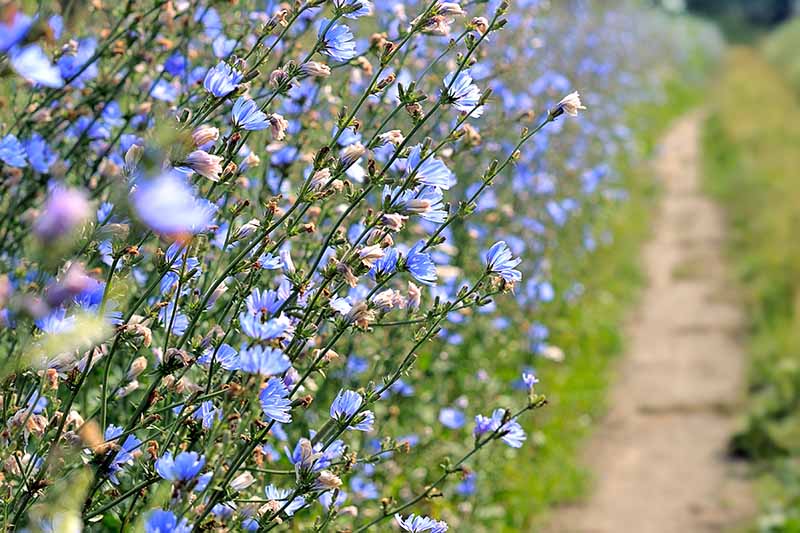
Still, this probably isn’t a plant that you want growing front and center in an ornamental garden, given its underwhelming leaves and stems.
But it certainly deserves a place amongst your edibles. The charming blooms are just a bonus.
These days, chicory isn’t one of those plants that you’ll find growing in every kitchen garden, but it has an incredibly storied past that includes a place in the Talmud and in the garden of one of Western history’s most famous botanists.
The root makes a tasty, if bitter, substitute for coffee, and it’s gained a reputation as a health food thanks to its high inulin content. The leaves and flowers are edible as well.
Ready to dedicate some space in the garden to this unassuming herb? Here’s what I’ll cover:
What You’ll Learn
Don’t worry if you’ve never grown chicory before. It’s one of those plants that makes everyone look like they have the greenest thumb.
Let’s get gardening!
What Is Chicory?
Chicory is a perennial herb that has proven so useful and persistent that we humans have brought it with us practically whenever we go.
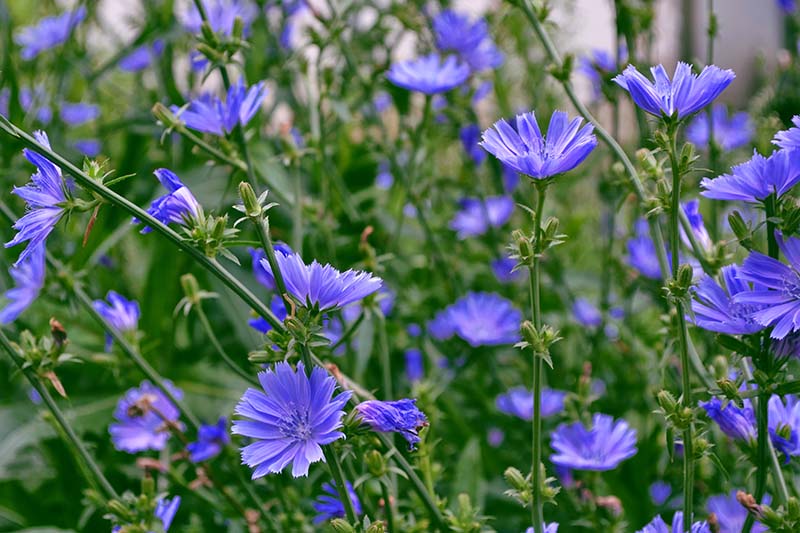
That’s why you can find it today pretty much everywhere, from Europe to North America, throughout the UK, China, Southeast Asia, southern Africa, and Australia.
It has manage to naturalize wherever it can get its roots into disturbed soil.
Humans have been cultivating this plant for centuries, and in that time they have managed to turn the basic wild plant into leafier versions like endive, sugarloaf, and radicchio.
Confusingly, you may have even heard endive called chicory in the US. These leafy vegetables are subspecies of C. intybus, and they’ll be covered in a separate growing guide.
You’ll also hear the plant referred to by various common names including blue sailor, coffeeweed, blue cornflower, Italian dandelion, succory, or wild endive (not to be confused with Cichorium pumilum, which is also called wild endive).

To make things easy, when we talk about chicory in this article, we’re talking about Cichorium intybus – the original species plant that is grown as a flowering herb.
It’s a member of the aster or daisy family, Asteraceae, and is closely related to that other underappreciated “weed,” the dandelion.
Chicory grows as a self-seeding perennial in USDA Hardiness Zones 3-10.
The stems are stiff and hairy, reaching up to three feet tall. The leaves are sparsely spaced and heavily toothed, with larger, fuller leaves at the bottom of the plant.
The flowers are violet blue, ranging from light to dark, depending on their age and level of sun exposure. You may even spot white flowers, though they are rare. The plant flowers from June through September.
Each of the flower heads is actually an inflorescence, or group of flowers. Each “petal” is really five fused petals that form a floret.
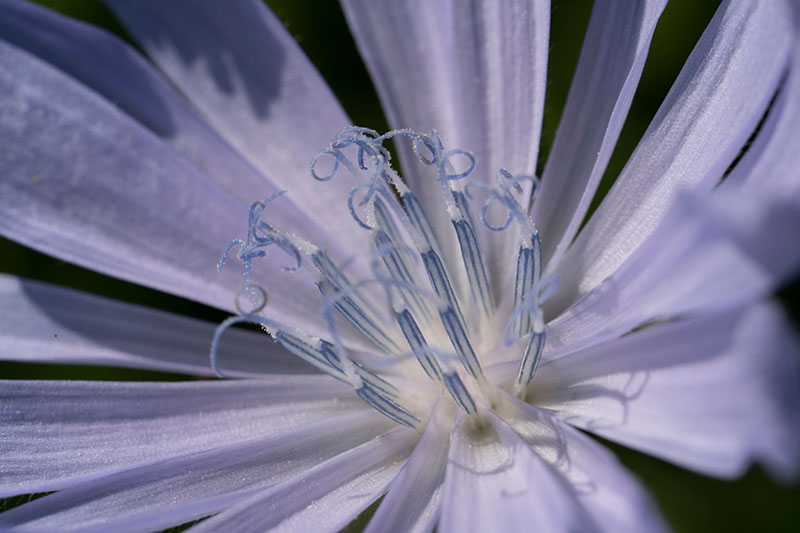
One of the things I find most fascinating about plants in the aster family is that they have flowers that open and close according to the movement of the sun.
The flower heads open before sunrise and start to close by the afternoon. They typically start out as dark blue lavender and seem to reflect the shift in the sky as both the flower and the sky lighten throughout the day.
White pollen gathers at the tips of the stamens throughout the early morning, when bees and butterflies will visit.
Each individual flower will never open again, and within a day or two, the flowers that have already bloomed will fall off.
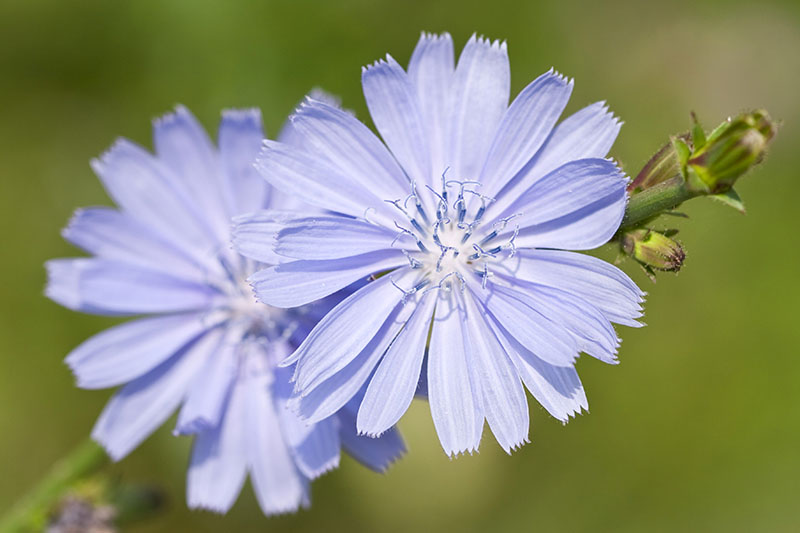
Later in the year, flowers that have been pollinated develop fruits that fall to the ground, and the seeds contained inside will germinate, starting the cycle all over again.
Like its buddy the dandelion, chicory has a long taproot, and both the leaves and root are nutritious and edible.
Cultivation and History
C. intybus originated in Eurasia, primarily in the Mediterranean and northwest Asia. It’s a plant that has laced itself into the fabric of human history.

It has been used in traditional Chinese medicine, and the ancient Roman poet Horace spoke about eating chicory regularly.
In the Bible, the Book of Exodus mentions bitter herbs as one of the foods to be consumed for Passover.
The Talmud later expanded on the types of herbs that were to be used, and one of these bitter herbs mentioned specifically is ulshin, or chicory.
Thanks to its blooming habit, the Swedish botanist Carl Linnaeus included chicory in his “floral clock.”
This clock was a garden filled with flowers that bloom at different times of day to indicate the time.
Chicory marked the four o’clock hour in the early morning in Sweden, because the flower heads begin to open just before the sunrise there, and close again in the afternoon.
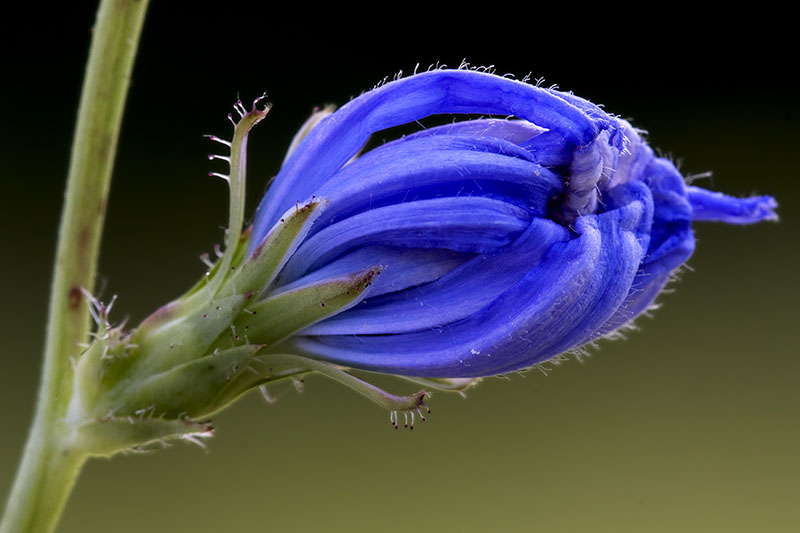
Chicory root became popular in the 1800s in Europe and was carried to other parts of the world.
It became popular in New Orleans after blockades during the American Civil War prevented coffee from reaching the port in the city. It remains a common coffee additive today.
When the British sought to colonize India, they brought the root along, and it gradually gained popularity as a brewed hot drink.
Chicory is not only cultivated for human consumption, but as fodder for livestock as well.
It has been used in Europe to feed animals for centuries, and more recently in the US, because it’s nutritious and drought tolerant.
Propagation
If you plan to harvest the roots, make sure your soil is friable and loose.
Otherwise, prepare the soil by adding a bit of sand to improve drainage if you have heavy clay soil.
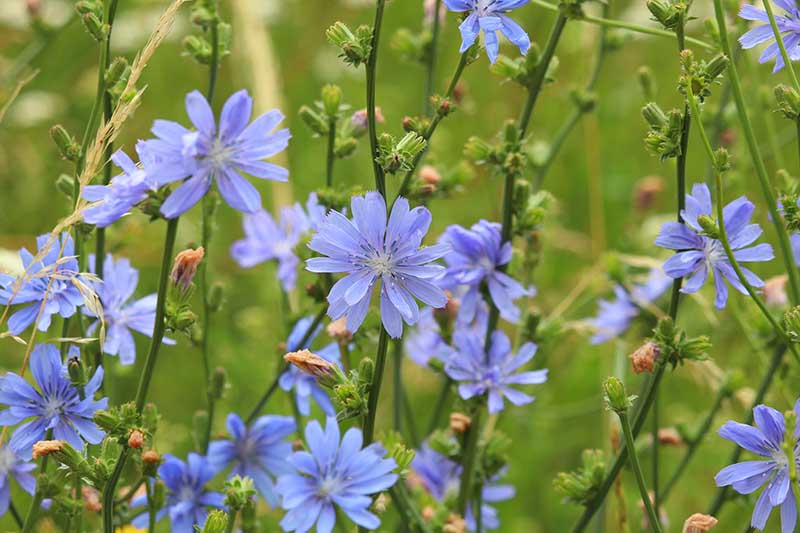
While chicory isn’t a demanding plant, as evidenced by its ability to thrive along neglected roadsides, you should test your soil and work in some well-rotted compost if it lacks any of the major nutrients.
If you want to encourage leafing, particularly if you’re growing it for fodder, give the plants a nitrogen-heavy fertilizer at seeding time, unless your soil is already high in nitrogen.
From Seed
Starting from seed is an easy and affordable way to grow a lot of plants. It takes little work and you’ll be rewarded with a large harvest.
Sow seeds directly into the soil in the early spring, as soon as the soil is workable. Don’t bury the seeds too deep – 1/4 inch is plenty.
Keep the soil moist but not wet until the seedlings emerge, which will usually take two to three weeks.
Seeds will germinate in a broad range of temperatures (remember, these plants are the definition of unfussy).
While temperatures between 40 to 85°F will get the job done, 70°F is the sweet spot for germination.
Once the plants pop up, thin them to one foot apart.
You can plant a second batch in midsummer if temperatures won’t go above 85°F.
How to Grow
Try to give C. intybus full sun. It can handle part shade, but it does best with six hours or more of sunlight per day.
Fertile, well-draining soil will give you the leafiest growth and healthiest roots. Aim for a pH somewhere between 5.5 and 7.0.

The plants prefer to have evenly moist soil, so make sure they’re getting at least an inch of water a week. The soil shouldn’t be allowed to dry out beyond the top inch.
It prefers disturbed areas like roadsides, pastures, landfills, and abandoned or disturbed land.
The seeds aren’t dispersed by the wind like those of the dandelion, so it won’t pop up in random spots unless a bird carries the seed.
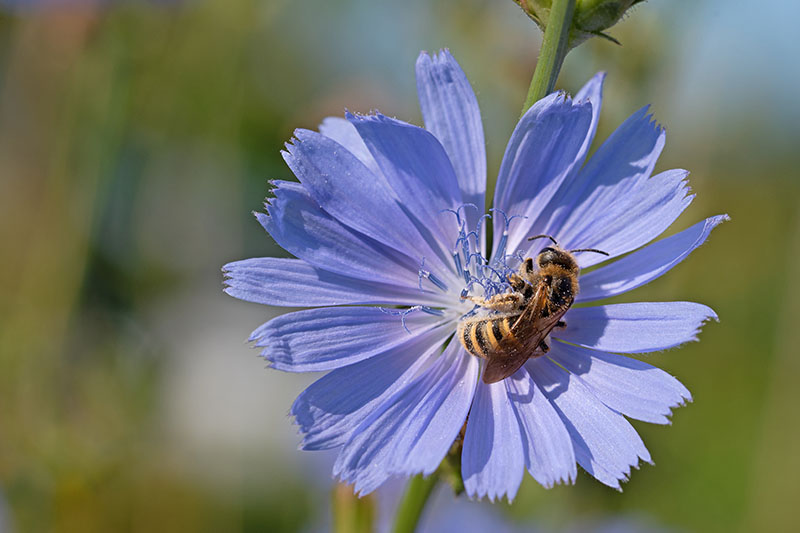
That means you won’t need to fight it’s spread as much as, say, mint, but keep an eye out and pull up any volunteers that sprout where you don’t want them.
You’ll need to dig up chicory in the same way you would dig up dandelions if you want to remove it from an area, using a long dandelion weeder to pull the entire taproot out of the soil.
Snip the blossoms when they are finished blooming to prevent re-seeding.
Growing Tips
- Plant in full sun in well-draining soil
- Keep the soil moist but not wet
- Control spread by pulling volunteers
Cultivars to Select
Most C. intybus seeds are sold under the generic name of “chicory.”
You can find seeds in a variety of packet sizes available at Eden Brothers.
However, there are a couple of cultivars to keep an eye out for.
Magdeburg
This heirloom variety matures in 120 days for root harvest and is noted for its large, robust roots.
It’s perfect if you’re hoping to grow the plant to harvest and use the roots as a coffee substitute.
Italiko Rosso
Another heirloom variety, this type has red stems and longer leaves. It’s sometimes called “red dandelion,” but it’s actually chicory.
This is the type to grow if you want to harvest the leaves for salads or to cook with them. The leaves are ready in just 40 days.
Managing Pests and Disease
One of the nicest things about this plant is that you’ll only bump up against pests and diseases on occasion.
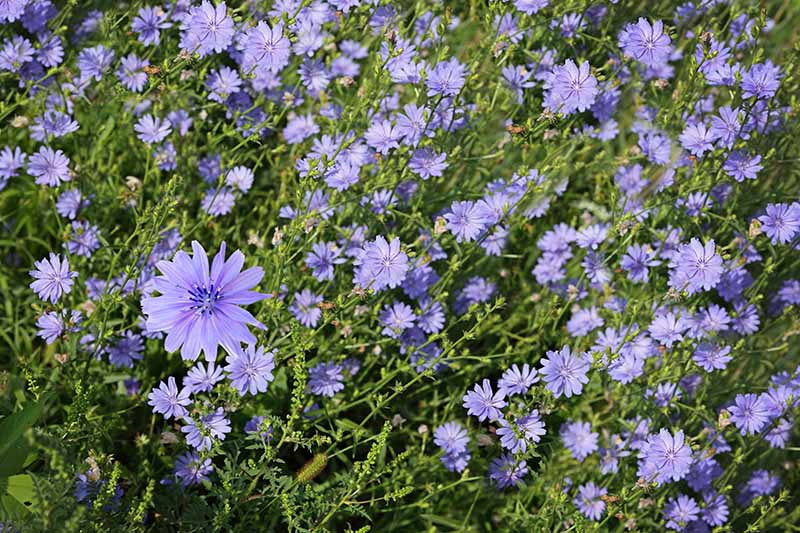
Provide good drainage, water at the base rather than sprinkling the foliage, and watch for bugs on a regular basis, and you should be good to go.
Avoid planting cultivated leaf chicory like endive and radicchio nearby because they share many of the same pest and disease issues.
Insects
The only pests that bug C. intybus are the usual suspects: aphids and slugs. Luckily, they’re both pretty easy to deal with.
Aphids
Aphids are the bane of every gardener’s existence at some point.
The little sap-suckers like to congregate on plants, stunting their growth and causing yellowing or distorted leaves.
They spread disease, too. This plant is susceptible to a number of different aphid species, but the small chicory aphid (Aphis intybi) is most common.
You can sprinkle your plants with flour, which will constipate the little bugs.
You can also mix a tablespoon of liquid dish soap with a quart of water and spritz your plants once a day for two weeks, or longer if the aphids seem to be sticking around.
Neem oil is another effective option. Apply according to the manufacturer’s directions once a week for three weeks.
Read more about managing aphids in the garden here.
Slugs
Slugs will happily make a meal out of your chicory, if given the chance.
Fortunately there are lots of natural ways to protect your plants from slugs and snails.
Be sure to remove any readily available hiding spots, like plant debris, wooden boards, and garden decor in the planting area.
Handpick the slimy little pests whenever you come across them, which is typically at night or after rainstorms.
You can also create a variety of traps, including the infamous beer trap using a cup of beer sunk into the garden.
I like to have a cup of beer available for myself while I walk around my garden looking for snails, but maybe that’s just me.
Disease
Every disease that attacks C. intybus sets in when the weather is moist and warm.
What does that mean for you? When the heat of summer hits, you need to be vigilant.
Planting in well-draining soil and being sure to water in the morning helps. That way, plants have time to dry off during the day.
You should also try to always water at the soil level and avoid splashing water onto the plant itself.
Anthracnose
Anthracnose is caused by a fungus, Microdochium panttonianum, that attacks all plants in the daisy family.
You’ll see gray or tan spots on the leaves of the plant, which can merge together and turn necrotic.
It thrives in warm, moist conditions and overwinters in the soil on plant debris. That’s why it’s important to weed regularly and clean up garden beds in the fall.
You should also rotate out your chicory if you have this disease in your garden.
Plant it in a different spot and don’t plant any other type of chicory in the same place again for at least two years.
There’s no effective treatment available, so pull and destroy your plants (don’t compost them) and keep up with the best practices mentioned above.
Bacterial Soft Rot
Bacteria in the Erwinia genus cause soft rot, which looks like water-soaked lesions on the leaves of your plants. These lesions can crack and ooze a slimy black or tan liquid.
It’s gross, trust me. You don’t want this in your garden, especially since there’s no cure.
This disease favors warm, moist conditions. To avoid it, clean your tools between uses, and water at the base of plants.
Make sure the soil is well-draining, and keep aphids away from your garden, since they can spread it.
Fusarium Wilt
Fusarium wilt is caused by fungi in the Fusarium genus, and it’s carried in the soil. Once again, this disease prefers moist, warm conditions.
It causes plant leaves to turn yellow and start drooping.
Make sure to test your soil before adding nitrogen, since high levels of nitrogen increase susceptibility to this disease.
You should also keep weeds away and remove and dispose of any infected plants well away from the compost pile, to avoid further spread.
If you have more than a few plants infected, it’s time to get some chemical assistance.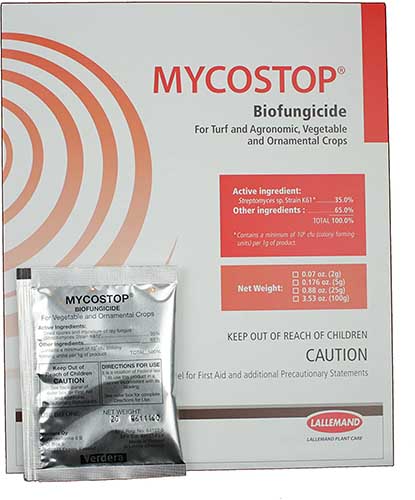
In the event of an advanced case that continues to destroy your crops despite your efforts, you can turn to the fungicide Mycostop, available on Amazon.
Follow the manufacturer’s directions for use, which involves mixing with water and soaking the soil or applying it to the foliage of your plants.
You can also use this product as a preventative measure.
Harvesting
If you plan to use the roots, harvest them in the first year after the plants have flowered. This typically happens around 120 days after planting the seeds.
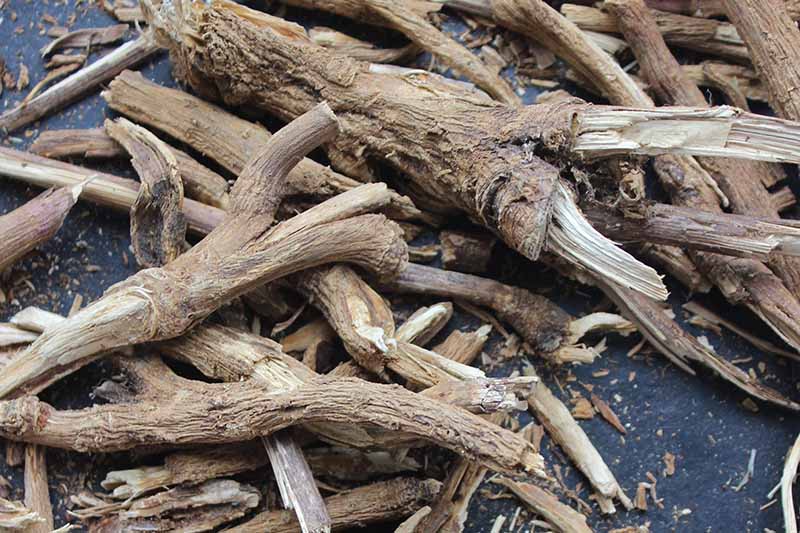
After the first year of growth, the roots get woody.
To harvest them, dig a few inches around the plant and gently tug the long taproot to pull it free.
You can pluck the leaves and flowers whenever you want them, but the leaves are best when young, and before the plant flowers.
Preserving
Preserve the roots to use as a coffee substitute by cleaning and scraping away the skin. Then, cut them into inch-long pieces.
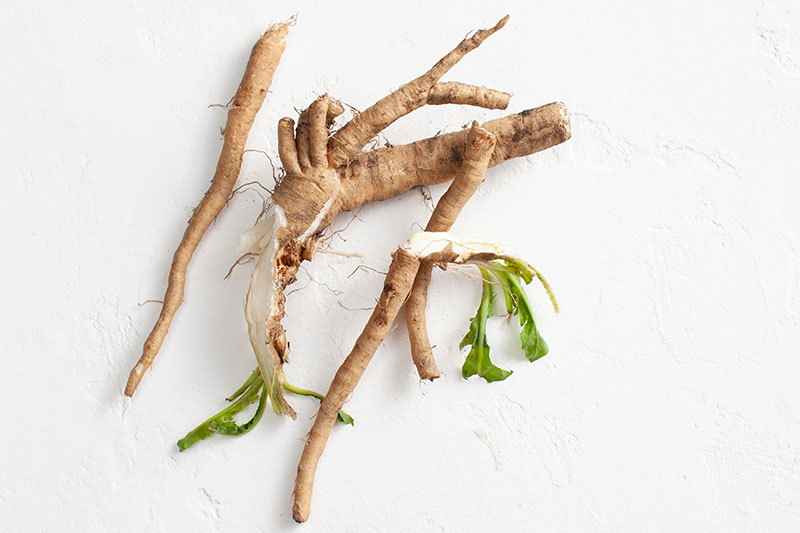
Put the pieces on a cookie sheet and roast them at 325°F until they turn dark brown.
This takes anywhere from 45 minutes to a couple of hours, depending on how thick the roots are.
Keep an eye on them as they roast and turn them occasionally if they start to cook unevenly. If you smell a coffee-like scent, it’s time to pull them out.
Put the pieces on a plate or tray and let them cool completely and grind them up as you would coffee beans.
I keep the cooked pieces in my fridge to extend their shelf life and then grind them up as needed, but you can also grind them up all at once.
The succulent leaves don’t dry well, so use them right away. You can store harvested leaves in a sealed plastic bag in the fridge for up to a week.
Wait to wash them until just before use to make them last longer. Wet leaves will rot more quickly.
The flowers can be used fresh or you can infuse them with vinegar to extend their shelf life.
Recipes and Cooking Ideas
Chicory, particularly the root, makes a healthy addition to any diet. The root contains the prebiotic fiber inulin, which is also found in Jerusalem artichokes.

In recent years, manufacturers have been adding ingredients like chicory root to a range of products – including things like cookies, water, and cereals – to increase the fiber content of foods and beverages.
While more dietary fiber is generally a good thing for most people, Christy Brisette at the Washington Post notes that it can also lead to digestive upsets if you don’t realize how much you have consumed.
This potential issue poses less of a risk if you eat primarily whole foods rather than packaged products and processed items, and knowingly getting your inulin straight from the root source.
Speaking of health benefits, there has been at least one study on animals that shows chicory might be able to help individuals to manage diabetes and obesity.
Read more in our guide to the health benefits of chicory (coming soon!).
There are lots of ways to use this plant, as many different groups of people have discovered over the years.
The root makes a delicious coffee substitute or extender that’s popular in some parts of the US.
As an extender, start with a mix of one part ground chicory and four parts ground coffee and brew as you would regular coffee. You can adjust from there based on taste.
This is actually its most famous use, but the root can serve other culinary purposes as well.
Here’s one of my favorites: the young, tender roots are delicious boiled or roasted and covered in butter, salt, and pepper.
The leaves can be eaten fresh or cooked, just as you’d use dandelion leaves.
It’s baffling to me that the dandelion has finally earned more widespread recognition for its tasty leaves in supermarkets, while chicory remains in the background.
I find the young raw leaves have a far superior flavor to dandelion, and they may be used in a similar fashion.
The older leaves are still edible, but here’s a word to the wise: cook them first. They are intensely bitter unless you tame them a bit with some boiling water.
I like to toss the flowers into salads or cocktails.
If you plan to use chicory as fodder for your animals, don’t let it go to seed. Typically, it should be mowed down three or four times a year.
The clippings may be fed to horses, cattle, rabbits, and poultry.
Quick Reference Growing Guide
| Plant Type: | Perennial Herb | Maintenance: | Low |
| Native To: | Eurasia | Tolerance: | Disturbed ground, drought |
| Hardiness (USDA Zone): | 3-8 | Soil Type: | Average, sandy |
| Bloom Time / Season: | Spring, summer | Soil pH: | 5.5-7.0 |
| Exposure: | Full sun | Soil Drainage: | Well-draining |
| Spacing: | 12 inches | Attracts: | Bees, butterflies |
| Planting Depth: | 1/4 inch | Companion Planting: | Beet, carrot, cucumber, radish, onion |
| Height: | Up to 4 feet | Avoid Planting With: | Endive, radicchio |
| Spread: | 1-2 feet | Order: | Asterales |
| Time to Maturity: | 40 days (leaves), 120 days (roots) | Family: | Asteraceae |
| Water Needs: | Moderate | Genus: | Cichorium |
| Pests & Diseases: | Aphids, snails; anthracnose, bacterial soft rot, fusarium wilt | Species: | intybus |
Chicory Deserves a Second Look
I think of chicory as dandelion’s quiet cousin. It doesn’t get the same level of attention – either good or bad – that dandelion does.
And while the leaves of the sunny yellow bloomer have found their way into grocery stores and farmers markets, chicory still waits to the side for the spotlight.

It deserves a second look. With its tasty and nutritious root, you can make a cup of decaf “coffee” that some people, myself included, prefer to the usual cuppa.
It also has a much lighter impact on the environment when you grow it yourself in comparison to coffee.
Just think of all the water, processing, and fuel required to roast and transport coffee beans.
Of course, it’s also a valuable food for livestock, and the leaves are worthy of a spot in the garden in their own right.
If you like chicory, and want to learn more about other medicinal plants, check out these guides next:
- How to Grow and Use Motherwort
- How to Harvest and Use Stinging Nettle Root
- Fun with Dandelions: Food and Medicine
© Ask the Experts, LLC. ALL RIGHTS RESERVED. See our TOS for more details. Product photos via Eden Brothers and Vivagrow. Uncredited photos: Shutterstock. With additional writing and editing by Allison Sidhu.
The staff at Gardener’s Path are not medical professionals and this article should not be construed as medical advice intended to assess, diagnose, prescribe, or promise cure. Gardener’s Path and Ask the Experts, LLC assume no liability for the use or misuse of the material presented above. Always consult with a medical professional before changing your diet or using plant-based remedies or supplements for health and wellness.
The post How to Grow Common Chicory appeared first on Gardener's Path.

